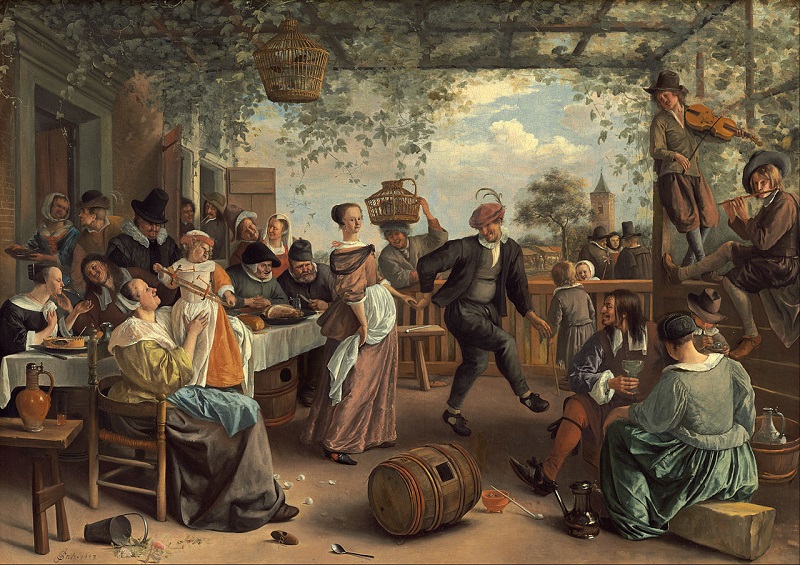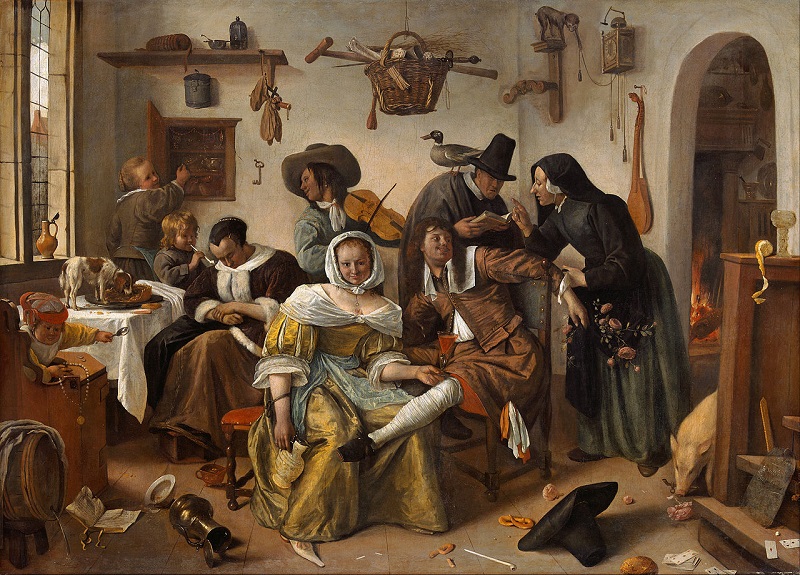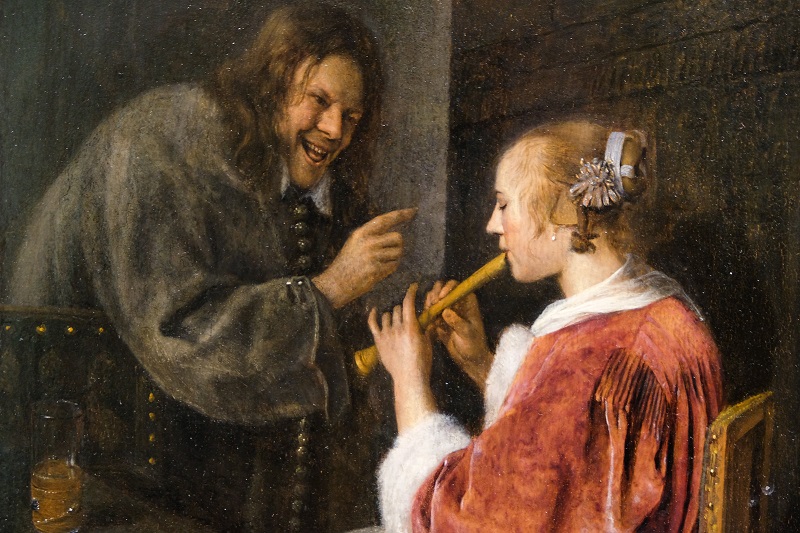Why is that man laughing?
This fine little panel painted by Dutch artist Jan Steen (1626-1679) depicts a common subject at the time—a private music lesson or performance with romantic subtext. These compositions are often laced with subtle and witty references to seduction. This piece, memorable as it is for the animated expression on the man's face, is especially intriguing when you discover that the models for the subjects of the painting are Steen himself and his wife Margaretha (Grietje).
Jan Steen, The Music Lesson, circa 1650
Steen is famous for paintings which meld keen observation and sharp humor with impeccable rendering and a generous sympathy for the human condition; he painted a range of subjects from bawdy tavern scenes to tender family groups and biblical epics. What makes Steen's work memorable is his sense of humor; it is at turns self-deprecating, satirical and lascivious (or all three). Steen's paintings often feel like stills from a film, or bits of story that is going on around the viewer. He often "cast" himself and members of his family in his little tales of comedy and morality—thus any moral to the story is gently steered away from seeming overly preachy or self-righteous.

Jan Steen, The Dancing Couple, 1663. From the collection of The National Gallery of Art.
Jan Steen's wife was the daughter of another Dutch artist, and one of his teachers, Jan van Goyen. Popular accounts of Steen's life as one ridden with debt and revelry are probably exaggerated based on the subject matter which he often painted. He was, it seems, a restless fellow and although he died in the city of his birth (Leiden), he lived in many places in between, and although painting was his first, and most constant career—he also worked as a brewer and an innkeeper. It's easy to imagine that he would enjoy the social nature of those businesses and the opportunity to observe people going about their lives in unguarded relaxation.

Jan Steen, Beware of Luxury, 1663. From the collection of Kunsthistorisches Museum Wien.
Visit the museum to look closely at this small painting. The two figures are wedged together by a tight arrangement of furniture—a table in the left foreground (with a drink upon it), a large, carved wooden object to the right—which may be the headboard or footboard of a bed (which often appear to the side or in the background of similar paintings) or perhaps a room divider. The teacher (Steen) leans forward over a hobnail chair. In spite of the tight space and the commanding male figure, the woman (Steen's wife) projects utter calm and serenity. Her eyes are closed and she seems to be truly concentrating on her playing. The details of her red-velvet, fur-trimmed jacket, jewelry, and hair ornament are beautifully rendered. Her face is lovely—even after 350 years her cheeks have a fetching glow and her eyelashes, minute as they are, are perfectly delineated. The man, on the other hand, is all action and outward energy. His mouth is open in a gleeful, expressive laugh or exclamation. We wish we knew what he was saying. His eyes have a demonic glint. The moods of the two seem opposed and yet they balance each other. Perhaps, rather than a scene of seduction, as many of these "music lesson" themed paintings are, this is a scene of marriage, in which two opposing energies rightly complement each other. He is boisterious, demonstrative, garrulous-; she is self-composed, perhaps slightly amused, focused on her music. But, we know the music she plays is eliciting a powerful response from her audience—and the exact nature of that response can only lead us back to a movie metaphor. It's time to cut and fade to black.

(For some fun, think of Steen like Hitchcok—a director who likes to make witty cameos in his own works. You can visit Google Arts & Culture to see if you can spot him—and Grietje in some other paintings.)
Jan Steen, The Dancing Couple, 1663. From the collection of The National Gallery of Art.
Jan Steen's wife was the daughter of another Dutch artist, and one of his teachers, Jan van Goyen. Popular accounts of Steen's life as one ridden with debt and revelry are probably exaggerated based on the subject matter which he often painted. He was, it seems, a restless fellow and although he died in the city of his birth (Leiden), he lived in many places in between, and although painting was his first, and most constant career—he also worked as a brewer and an innkeeper. It's easy to imagine that he would enjoy the social nature of those businesses and the opportunity to observe people going about their lives in unguarded relaxation.
Jan Steen, Beware of Luxury, 1663. From the collection of Kunsthistorisches Museum Wien.
Visit the museum to look closely at this small painting. The two figures are wedged together by a tight arrangement of furniture—a table in the left foreground (with a drink upon it), a large, carved wooden object to the right—which may be the headboard or footboard of a bed (which often appear to the side or in the background of similar paintings) or perhaps a room divider. The teacher (Steen) leans forward over a hobnail chair. In spite of the tight space and the commanding male figure, the woman (Steen's wife) projects utter calm and serenity. Her eyes are closed and she seems to be truly concentrating on her playing. The details of her red-velvet, fur-trimmed jacket, jewelry, and hair ornament are beautifully rendered. Her face is lovely—even after 350 years her cheeks have a fetching glow and her eyelashes, minute as they are, are perfectly delineated. The man, on the other hand, is all action and outward energy. His mouth is open in a gleeful, expressive laugh or exclamation. We wish we knew what he was saying. His eyes have a demonic glint. The moods of the two seem opposed and yet they balance each other. Perhaps, rather than a scene of seduction, as many of these "music lesson" themed paintings are, this is a scene of marriage, in which two opposing energies rightly complement each other. He is boisterious, demonstrative, garrulous-; she is self-composed, perhaps slightly amused, focused on her music. But, we know the music she plays is eliciting a powerful response from her audience—and the exact nature of that response can only lead us back to a movie metaphor. It's time to cut and fade to black.
(For some fun, think of Steen like Hitchcok—a director who likes to make witty cameos in his own works. You can visit Google Arts & Culture to see if you can spot him—and Grietje in some other paintings.)



